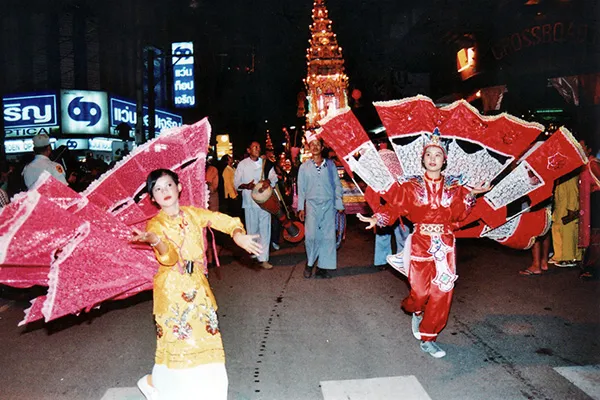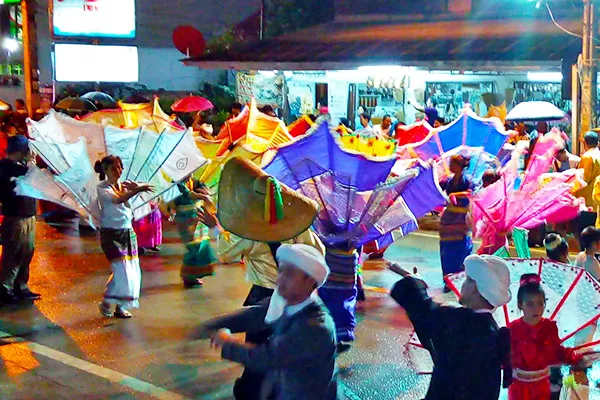Gingala (Bird Dance):
These captivating performances grace festivals and significant occasions, adding a vibrant touch to events such as welcoming esteemed guests or foreign dignitaries, commemorating the culmination of Buddhist Lent, and observing various customs. A notable feature of Shan artistry is the dance known as “Gingala,” a mesmerizing portrayal of avian grace. During this performance, dancers engage in playful taunts, each infusing their unique style, harmoniously blending into a natural and exquisite choreography synchronized with the rhythm. The dance unfolds seamlessly, an uninterrupted flow guided by the beat of drums and accompanying musical instruments. Dancers channel their distinct personas, coalescing their movements until a predetermined signal signifies the graceful and harmonious conclusion. The duration of the dance remains fluid, adapting to the moment, while the performance necessitates a spacious venue to allow dancers the freedom to express their individual styles with ease. Prior to the performance, a teacher worship ceremony sets the tone, establishing a sense of reverence and connection to tradition, heightening the significance of the ensuing artistic expression.
Gato (To Dance):
Gato, also known as Rum To, constitutes a captivating form of performance indigenous to Mae Hong Son province. Reminiscent of a Chinese lion dance, Gato delivers an engaging and delightful spectacle. The presentation involves a pair of dancers, with one positioned at the forefront, resembling the head, while the other occupies the rear, symbolizing the tail. Characteristic of Gato is its fluid and dynamic nature, lacking rigid dance styles. Instead, the performance harmonizes with the rhythm of accompanying music or song. The dancers adapt their movements in sync with the melody, resulting in an ever-evolving display of artistic expression. Gato takes center stage during festivals and significant occasions, playing an integral role in welcoming esteemed visitors, foreign dignitaries, celebrating the conclusion of Buddhist Lent, and upholding cherished traditions. The allure of Gato lies in its ability to captivate and entertain, drawing spectators into a realm of cultural significance and artistic charm.
Jaad Tai (A Shan Musical Folk Drama):
A Jaad Tai performance unfolds as a grand spectacle, featuring an ensemble of 20 to 50 or even more performers, varying based on the specific Jaad Tai troupe. This presentation serves as a vibrant reflection of Shan culture, encapsulating the essence of their artistic heritage. Drawing parallels, Jaad Tai can be likened to the Thai musical folk drama seen in the central region, complete with a cast of actors and musicians. The production is brought to life on an elaborately designed set and stage, each detail carefully orchestrated to align with the narrative. Rooted in local Myanmar traditions, Jaad Tai takes on a unique Shan flavor through its adaptation known as “Lige Tai.” This artful transformation by the Shan community lends an indigenous touch, infusing the performance with their distinctive artistic expression and cultural nuances. As a result, Jaad Tai becomes a vibrant testament to the cross-pollination of artistic influences, weaving a tapestry of entertainment that resonates with both tradition and innovation.
Galaew (Sword Dance):
Throughout its historical trajectory, the Shan nationality endured a tumultuous past marked by recurrent evacuations precipitated by invasions from neighboring groups. Their fate hinged on the ebb and flow of leadership capabilities, with victories and defeats shaping their destiny. In the face of defeat, the Shan people migrated to new territories, necessitating the perpetual acquisition and preservation of defensive skills. At the heart of Shan martial tradition stands the “Laew,” a sword that emerges as a quintessential individual weapon. The mastery of swordplay, dating back to ancient times, holds paramount significance. Both the use of the sword and the art of sword dancing have been ingrained in the Shan culture through generations. Notably, the sword dance is accompanied by a captivating song, intertwining rhythmic movements with a compelling narrative. This sword dance epitomizes a mesmerizing blend of tradition and skill, a testament to the Shan people’s resilience and adaptability. The artistry of the dance not only underscores the importance of self-defense but also serves as a poignant reminder of the challenges and triumphs that have sculpted the Shan identity over time.
Rum Tai:
Rum Tai stands as a distinguished dance form that encapsulates the distinctive essence of Shan culture within Mae Hong Son province. This captivating art conveys the Shan people’s graceful and genteel way of life, exuding a sense of courtesy and humility that extends to welcoming visitors. The dance is a collective endeavor, with participants synchronizing their movements to the rhythm, exuding precision and meticulousness. An embodiment of the Shan culture’s elegance and grace, Rum Tai holds a significant place in festivals and notable occasions. Its enchanting performance graces events such as welcoming esteemed guests, hosting foreign dignitaries, marking the conclusion of Buddhist Lent, and observing revered traditions. The dance not only entertains but also serves as a living testament to the Shan people’s cultural values, inviting audiences to immerse themselves in the beauty and authenticity of their heritage.


